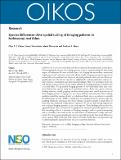Files in this item
Species differences drive spatial scaling of foraging patterns in herbivorous reef fishes
Item metadata
| dc.contributor.author | Chow, Cher F Y | |
| dc.contributor.author | Wassénius, Emmy | |
| dc.contributor.author | Dornelas , Maria | |
| dc.contributor.author | Hoey, Andrew S | |
| dc.date.accessioned | 2021-11-01T17:30:13Z | |
| dc.date.available | 2021-11-01T17:30:13Z | |
| dc.date.issued | 2021-12 | |
| dc.identifier | 275955623 | |
| dc.identifier | 29627273-3a65-4860-a58b-3138a6f0259a | |
| dc.identifier | 85118110088 | |
| dc.identifier | 000711034900001 | |
| dc.identifier.citation | Chow , C F Y , Wassénius , E , Dornelas , M & Hoey , A S 2021 , ' Species differences drive spatial scaling of foraging patterns in herbivorous reef fishes ' , Oikos , vol. 130 , no. 12 , pp. 2217-2230 . https://doi.org/10.1111/oik.08713 | en |
| dc.identifier.issn | 0030-1299 | |
| dc.identifier.other | ORCID: /0000-0002-1020-8409/work/102726023 | |
| dc.identifier.uri | https://hdl.handle.net/10023/24237 | |
| dc.description | Funding was provided by the Australian Research Council (DE130100688) and Isobel Bennett Marine Biology Fellowship from the Lizard Island Reef Research Foundation to ASH. CFYC was supported by funding granted to MD by the Leverhulme Centre. MD is supported by a National Science Foundation–Natural Environment Research Council Biological Oceanography grant (1948946), the Leverhulme Trust Research Centre–the Leverhulme Centre for Anthropocene Biodiversity and a Leverhulme Research Grant (RPG-2019-402). | en |
| dc.description.abstract | Herbivory is a core ecosystem function that is delivered heterogeneously across space. Disentangling the drivers of foraging patterns is key to understanding the functional impact of herbivores. Because intrinsic drivers of foraging like metabolism, nutritional requirements, and movement costs scale allometrically, foraging movement patterns in terrestrial herbivores have been shown to also scale positively with body size. However, spatial patterns of herbivory can also be explained by orthogonal factors such as trophic position, competition, and functional groupings. Here, we investigate body size and species traits as drivers of the spatial scaling of foraging patterns in herbivorous coral reef fishes. We quantified foraging patterns of 119 individuals from nine common herbivorous species using focal individual surveys. Body size, species identity, feeding substrata, social grouping, and functional group were tested as predictors of three foraging metrics: foraging area, inter-foray distance, and tortuosity. Our resulting model revealed that species identity overshadowed body size as a predictor in models for all foraging metrics. While foraging area was explained best by species only, the resulting tortuosity and mean inter-foray distance models included a small effect of body size that explained within-species variation. We do not find strong support for size-scaling of foraging patterns in our study species. These findings indicate that foraging allometry based on Optimal Foraging Theory cannot be generally applied to reef fish assemblages due to a diversity of foraging strategies, such as spatial partitioning and territoriality. Our work reveals the importance of behavioural ecology and taxonomic diversity in understanding herbivory, especially given the functional differences across species. With coral reefs under threat across the world, this is an important step to disentangling the spatial delivery of a core ecosystem function. | |
| dc.format.extent | 14 | |
| dc.format.extent | 1545593 | |
| dc.language.iso | eng | |
| dc.relation.ispartof | Oikos | en |
| dc.subject | Herbivory | en |
| dc.subject | Functional impact | en |
| dc.subject | Foraging ecology | en |
| dc.subject | Allometry | en |
| dc.subject | Coral reef fish | en |
| dc.subject | Functional delivery | en |
| dc.subject | Reef ecology | en |
| dc.subject | GC Oceanography | en |
| dc.subject | NDAS | en |
| dc.subject | SDG 15 - Life on Land | en |
| dc.subject.lcc | GC | en |
| dc.title | Species differences drive spatial scaling of foraging patterns in herbivorous reef fishes | en |
| dc.type | Journal article | en |
| dc.contributor.sponsor | The Leverhulme Trust | en |
| dc.contributor.institution | University of St Andrews. Centre for Biological Diversity | en |
| dc.contributor.institution | University of St Andrews. School of Biology | en |
| dc.identifier.doi | https://doi.org/10.1111/oik.08713 | |
| dc.description.status | Peer reviewed | en |
| dc.identifier.url | https://doi.org/10.5281/zenodo.5517171 | en |
| dc.identifier.grantnumber | en |
This item appears in the following Collection(s)
Items in the St Andrews Research Repository are protected by copyright, with all rights reserved, unless otherwise indicated.

